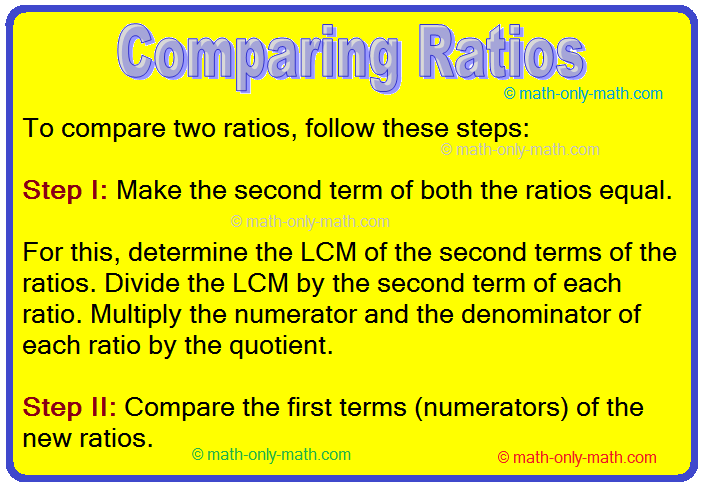Subscribe to our ▶️ YouTube channel 🔴 for the latest videos, updates, and tips.
Comparing Ratios
In comparing ratios we will learn how to arrange the ratios.
How to Compare Ratios?
To compare two ratios, follow these steps:
Step I: Make the second term of both the ratios equal.
For this, determine the LCM of the second terms of the ratios. Divide the LCM by the second term of each ratio. Multiply the numerator and the denominator of each ratio by the quotient.
Step II: Compare the first terms (numerators) of the new ratios.
Solved Examples on Comparing Ratios:
1. Which of the following ratios is grater?
Compare the ratios 3 : 4 and 1 : 2.
LCM of the second terms, i.e., 4 and 2 = 4
Now, dividing the LCM by the second term of each ratio, we get 4 ÷ 4 = 1, and 4 ÷ 2 = 2
Therefore, \(\frac{3}{4}\) = \(\frac{3 * 1}{4 * 1}\) = \(\frac{3}{4}\)
\(\frac{1}{2}\) = \(\frac{1 * 2}{2 * 2}\) = \(\frac{2}{4}\)
As 3 > 2, \(\frac{3}{4}\) > \(\frac{2}{4}\), i.e., 3 : 4 > 1 : 2
Therefore the ratio 3:4 is greater than the ratio 1:2 according to the ratio comparison rules.
2. Which of the following ratios is grater?
Compare the ratios 3 : 5 and 2 : 11.
LCM of the second terms, i.e., 5 and 11 = 55
Now, dividing the LCM by the second term of each ratio, we get 55 ÷ 5 = 11, and 55 ÷ 11 = 5
Therefore, \(\frac{3}{5}\) = \(\frac{3 * 11}{5 * 11}\) = \(\frac{33}{55}\)
\(\frac{2}{11}\) = \(\frac{2 * 5}{11 * 5}\) = \(\frac{10}{55}\)
As 33 > 10, \(\frac{3}{5}\) > \(\frac{2}{11}\), i.e., 3 : 5 > 2 : 11.
Therefore the ratio 3 : 5 is greater than the ratio 2 : 11 according to the ratio comparison rules.
Working Rules for Comparison of Ratios:
To compare two or more given ratios, follow the steps given below:
Step I: Write each one of the given ratios in the form of a fraction in the simplest form.
Step II: Convert these fractions into like fractions and then compare.
3. Compare the ratios 4 : 7 and 5 : 8.
Solution:
4 : 7 = \(\frac{4}{7}\) and 5 : 8 = \(\frac{5}{8}\)
LCM of 7 and 8 is 56.
\(\frac{4}{7}\) = \(\frac{4 × 8}{7 × 8}\) = \(\frac{32}{56}\) and \(\frac{5}{8}\) = \(\frac{5 × 7}{8 × 7}\) = \(\frac{35}{56}\)
Clearly, \(\frac{35}{56}\) > \(\frac{32}{56}\)
⟹ \(\frac{5}{8}\) > \(\frac{4}{7}\)
⟹ 5 : 8 > 4 : 7
Hence, 5 : 8 > 4 : 7
4. Write the following ratios in ascending order 4 : 3, 7 : 10, 4 : 7.
Solution:
4 : 3 = \(\frac{4}{3}\); 7 : 10 = \(\frac{7}{10}\) and 4 : 7 = \(\frac{4}{7}\).
LCM of 3, 7 and 10 = 210
\(\frac{4}{3}\) = \(\frac{4 × 70}{3 × 70}\) = \(\frac{280}{210}\)
\(\frac{7}{10}\) = \(\frac{7 × 21}{10 × 21}\) = \(\frac{147}{210}\)
\(\frac{4}{7}\) = \(\frac{4 × 30}{7 × 30}\) = \(\frac{120}{210}\)
Now \(\frac{120}{210}\) < \(\frac{147}{210}\) < \(\frac{280}{210}\)
⟹ \(\frac{4}{7}\) < \(\frac{7}{10}\) < \(\frac{4}{3}\)
⟹ 4 : 7 < 7 : 10 < 4 : 3
Hence, 4 : 7 < 7 : 10 < 4 : 3
Worksheet on Comparing Ratios:
1. Which of the following ratio is larger?
(i) 3 : 4 or 9 : 16
(ii) 15 : 16 or 24 : 25
(iii) 4 : 7 or 5 : 8
(iv) 9 : 20 or 8 : 13
(v) 1 : 2 or 13 : 27
Answer:
1. (i) 3 : 4 > 9 : 16
(ii) 15 : 16 < 24 : 25
(iii) 4 : 7 < 5 : 8
(iv) 9 : 20 < 8 : 13
(v) 1 : 2 > 13 : 27
● Ratio and proportion
- Basic Concept of Ratios
- Important Properties of Ratios
- Ratio in Lowest Term
- Types of Ratios
- Comparing Ratios
- Arranging Ratios
- Dividing into a Given Ratio
- Divide a Number into Three Parts in a Given Ratio
- Dividing a Quantity into Three Parts in a Given Ratio
- Problems on Ratio
- Worksheet on Ratio in Lowest Term
- Worksheet on Types of Ratios
- Worksheet on Comparison on Ratios
- Worksheet on Ratio of Two or More Quantities
- Worksheet on Dividing a Quantity in a Given Ratio
- Word Problems on Ratio
- Proportion
- Definition of Continued Proportion
- Mean and Third Proportional
- Word Problems on Proportion
- Worksheet on Proportion and Continued Proportion
- Worksheet on Mean Proportional
- Properties of Ratio and Proportion
Didn't find what you were looking for? Or want to know more information about Math Only Math. Use this Google Search to find what you need.



New! Comments
Have your say about what you just read! Leave me a comment in the box below. Ask a Question or Answer a Question.